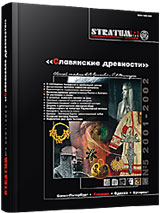Новый черняховский памятник на территории России
A New Cherniakhov Site in Russia
Author(s): Andrei M. OblomskiiSubject(s): History, Archaeology, Ancient World
Published by: Издательский дом Stratum, Университет «Высшая антропологическая школа»
Summary/Abstract: The article presents for scientific discussion materials collected on a complex of Cherniakhov sites Golovino-1, conducted in 1988-1989 by the expedition led by the author. The complex consists of a settlement and a small grave ground. The settlement is located on a promontory on the left bank of a gully, with a spring on the bottom of it, which is a source for the river Toplinka (the right tributary of the Severskii Donets). The settlement’s size is 50-110x130 m. The expedition set 3 diggings and a trench on the site, covering the total area of 800 sq. m. The recovered material from the settlement belongs to two cultural and chronological stages: late Zarubintsy and Cherniakhov. The finds of the early Roman time come from three earthen huts, four household pits and the cultural layer. The Cherniakhov period is represented by three earthen huts, a surface structure and household pit. The complex of hand-made vessels is represented by coarse ware with fire clay, glossy fine wares, and also by pottery made of porous paste with admixture of sand and organic material, and probably close to Wielbark cultural tradition. Wheel pottery is diverse and represented by sherds of pots, bowls, jars, vases and cups. Individual finds are represented by a series of clay spindle-whorls and weights, a grindstone, bronze objects – a fibula, two clasps, a belt’s ring, a ring of intertwisted rod; among other finds there are fragments of glass vessels and several iron articles – knives, a lock mechanism, a bucket arc, etc. Filling from the feature 5 yielded a copper coin, tetrasarius, presumably minted in Tyra between 238 and 253.The grave ground was located north of the settlement at a distance of about 50 m. The cultural layer of the grave ground yielded fragmented sherds of vessels which were twice baked, a burned spindle-whorl, some separate calcinated bones, including animal bones. All finds belong to the Cherniakhov time. There was found one cremation, four inhumations with fragmented or broken skeletons and one pit without the skeleton.The complex of sites in Golovino-1 is one of the earliest in the eastern periphery of the Cherniakhov culture. The fact is proved by Tanais-type amphorae, clasps of Soltan series, fibulae with high receiver, a copper coin dated by app. middle III c. found on the settlement. The early Cherniakhov materials can be found on a number of other settlements on the Dnieper’s left bank, in the basin of the Severskii Donets, which allows one to infer that the Cherniakhov people started inhabiting this area quite early, soon after the first Cherniakhov sites had appeared in the western part of the area of this culture.
Journal: Stratum plus. Археология и культурная антропология
- Issue Year: 2002
- Issue No: 5
- Page Range: 27-52
- Page Count: 26
- Language: Russian
- Content File-PDF

